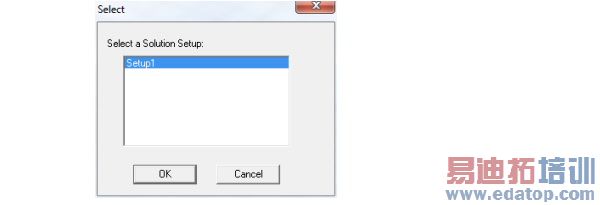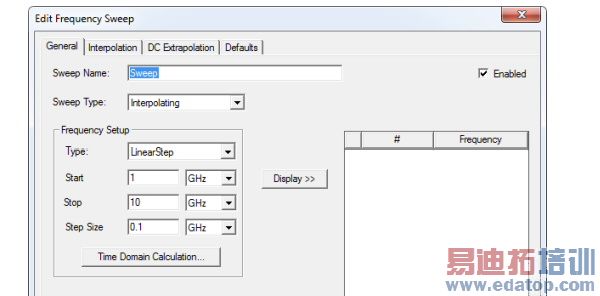- 易迪拓培训,专注于微波、射频、天线设计工程师的培养
HFSS15: Adding a Frequency Sweep
HFSS online help > Specifying Solution Settings
For Driven solution types.
To generate a solution across a range of frequencies, add a frequency sweep to the solution setup. HFSS or HFSS-IE performs the sweep after the adaptive solution. If an adaptive solution is not requested, the sweep is the only solution generated. You can also disable a sweep, so that you can run only the adaptive solution (or a ports-only solution) without the sweep, then later reactivate the sweep definition.
To add a frequency sweep:
1. Click HFSS>Analysis Setup>Add Frequency Sweep![]() .
.
A dialog appears which lists the solution setups.

2. Select the solution setup to which the sweep applies and click OK. To bypass this dialog right-click on the desired setup in the Project tree and select Add Sweep from the shortcut menu.
The Edit Frequency Sweep dialog box appears.

3. Specify the following sweep parameters:
• Sweep type - Discrete, Fast, or Interpolating (the default). Each selection affects the tabs and options available.
• Frequency Setup.
4. If you plan to perform a Full-Wave SPICE analysis, click Time Domain Calculation tool to obtain assistance determining a suitable frequency sweep range for the solutions. Also see the Requirements for Full-Wave SPICE.
5. If you expect to use the same settings often, you can got to the Defaults tab and click the Set Defaults button. To use previously saved settings, click the Use Defaults button.
6. Click OK.
Once you have created a sweep, an icon for the sweep appears in the Project tree under the associated setup. Selecting the sweep icon causes the docked properties dialog to show the name, start, stop, step size, and sweep type. It also includes an Enabled checkbox.
Edit, Copy and Paste Existing Sweeps.
You can select an existing sweep, use the Edit commands to Copy it, and then and Paste the sweep into the Project tree. (By default, the copy is named Sweepn, where n increments with each new sweep.) You can edit the new copies of the sweep to make desired changes. For example, you can change a specific parameter, or for a distributed solve, you could assign different start and end points for each copy of the setup.
The Paste command for sweeps is design sensitive (that is, you cannot paste between Driven and Eigenmode designs) and context sensitive (for example, a sweeps can only be pasted in a setup.) Dependent setups are pasted along with the copied setup. You are warned if the dependent setup is already in the design and setup is not pasted again.
Note | For a solve setup with zero passes, no sweeps, and that is not ports only, validation produces a warning message. |
HFSS 学习培训课程套装,专家讲解,视频教学,帮助您全面系统地学习掌握HFSS
上一篇:Access Near Field External Data File
下一篇:A Coax Connector


